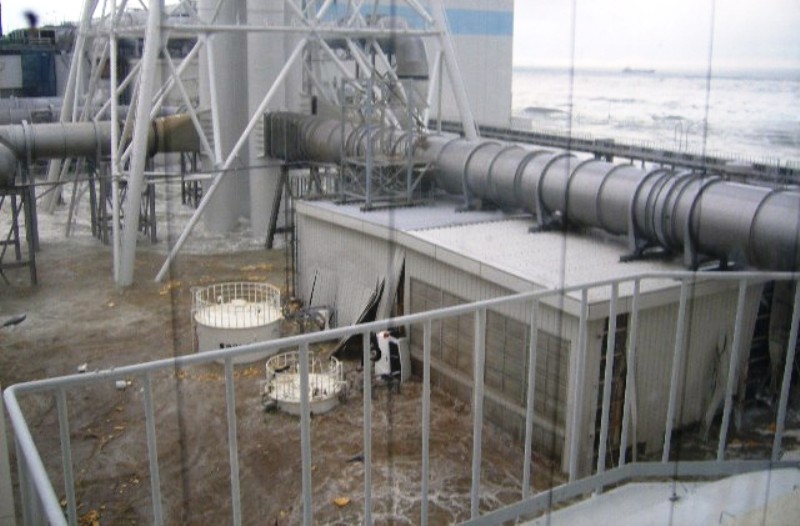On March 11, 2011, an earthquake measuring 9.0 on the Richter scale off the coast of Japan spawned a large tsunami wave that overtopped the protective seawall at the Fukushima Daiichi nuclear plant. The flood waters disabled emergency equipment. The three reactors operating at the time of the earthquake experienced extensive damage due to overheating.

Tsunami waters flooding the Fukushima Daiichi site. The gray rectangular structure with the horizontal band in the left background is one of the turbine buildings. In the upper right, the Pacific Ocean is shown overtopping the protective seawall. The cylindrical tubes are part of the ventilation system. Just below the center of the picture is a white SUV stood on its nose by the flood water. (Source: TEPCO)
In March 2012, the NRC ordered owners of operating nuclear reactors to walk down their facilities for earthquake and flooding vulnerabilities. Those efforts have already reaped dividends. For example:
- On May 24, 2012, workers at the Vermont Yankee nuclear plant (VT) discovered that the flood seal on an underground conduit (a metal tube encasing electrical cables) might not prevent flood water from flowing through the conduit into rooms housing electrical switches for power and control of emergency equipment. If these switches were disabled by the water, “the capability to shut down the reactor and maintain it is a safe shutdown condition” could be lost. Workers replaced the deficient flood seal with one of a different design.
- On August 12, 2012, workers at Three Mile Island Unit 1 (PA) discovered that seals in conduit for electrical cables through the air intake tunnel into the auxiliary building were not equipped with flood seals as called for in the plant’s design. The flood seals had never been installed when the plant was constructed in the 1970s. Had flood water entered the auxiliary building via the unprotected conduits, the owner reported that the “decay heat removal function” for the reactor core could have been impaired or lost as was that function for the Unit 2 reactor next door when it partially melted down on March 28, 1979.
- On October 15, 2012, workers at Millstone Unit 2 (CT) discovered 20 four-inch diameter conduits and two 2-inch diameter conduits that lacked flood seals as specified in the plant’s original design. The conduits, unsealed at both ends, passed between the intake structure and the turbine building. High water level at the intake structure (the building at the waterfront housing the pumps used to supply cooling water to the plant) could have transported water through the conduits into the turbine building and disabled the turbine-driven auxiliary feedwater pump – the emergency pump relied upon to remove heat from the reactor core following an accident or station blackout event.
Our Takeaway
For decades, these design deficiencies left these reactors more vulnerable to floods than necessary. The Fukushima disaster prompted reactions in the United States that found and fix these longstanding impairments. That’s good.
But what if these reactors had experienced the flood prior to March 2011 that it was supposed to be protected against, but was not? Perhaps workers in Japan would have walked down their plants for lessons from the Vermont Yankee, Millstone, or second Three Mile Island disaster.
Why weren’t these design problems found in the 2000s, 1990s, 1980s, or 1970s?
Lots of people spent lots of time allegedly looking for them.
For example, the NRC has inspection procedure 71111.06 titled “Flood Protection Measures” that requires two plant areas to be examined each year. The procedure explicitly guides NRC inspectors to give priority to “Sealing of equipment below the floodline, such as electrical conduits” in “areas that can be affected by internal flooding, including water intake facilities.”
And NRC inspection procedure 71111.01 titled “Adverse Weather Protection” has a section specifically chartered to “Evaluate Readiness to Cope with External Flooding” directing NRC inspectors to “select plant areas containment risk significant structures, systems, and components (SSCs) which are below flood levels or otherwise susceptible to flooding.”
Again, why didn’t these or other NRC inspections find at least some of these design problems in the 2000s, 1990s, 1980s, or 1970s? It’s not a case of one NRC inspector having a bad week – it’s a case of a regulatory agency having four bad decades.
The NRC should review its inspection efforts in light of all these reports and make changes necessary to improve their effectiveness.
And the NRC could take a complementary approach.
The NRC issues operating licenses to plant owners allowing them to operate their facilities within terms and conditions established by those licenses. The plant owners, not the NRC, have primary responsibility under the law to abide by those terms and conditions. Thus, plant workers rather than NRC inspectors are expected under the law to find and fix design deficiencies.
The mea culpas listed above clearly represent failures by plant owners to fulfill their obligations under the law. The NRC has the authority to fine owners for violating federal safety regulations. The NRC should take its federal safety regulations seriously by sanctioning owners who have violated them for decades.
When owners scoff at federal safety regulations, the American public expects the NRC to do more than join in the scoff chorus.
“Fission Stories” is a weekly feature by Dave Lochbaum. For more information on nuclear power safety, see the nuclear safety section of UCS’s website and our interactive map, the Nuclear Power Information Tracker.
